#Biomedical Research and Applications
Text
Bacillus Methylotrophicus: Advancements in Biomedical Research and Applications
In the last few years, the bacterium Bacillus methylotrophicus is under the vast interest in biomedical research as this microorganism possesses several peculiarities and can be applied in various clinical fields. Because this bacterium can metabolise methanol as the sole carbon source, it seems to hold great potential in a number of biotechnological and medical applications. The constant studies and developments in terms of discovering and especially in utilizing the potential of Bacillus methylotrophicus contribute to the creation of further medical and environmental breakthroughs.
Biological Characteristics and Mechanisms
Bacillus methylotrophicus is a Gram positive aerobic facultative, soil and plant roots inhabiting bacterium. They are well adapted to different environmental factors, and this makes the species to be all round in its well-being. This bacterium is known to produce a diverse number of bioactive compounds such as enzymes, antibiotics and secondary metabolites. Some of the above stated compounds have been proved to have antibacterial, antiviral, and anti-cancer effects and therefore Bacillus methylotrophicus is a gold asset in research activities especially in the medical field.
Biotechnology and Medical uses
1. Antimicrobial and Antiviral Properties: Bacillus methylotrophicus synthesises a manifold of antimicrobial peptides and enzymes that can neutralize pathogenic bacteria and viruses. Due to these occurrences, the public has an interest in the fact that these bioactive compounds are under research for the purpose of producing new antibiotics and antiviral agents especially with the current increase in the overpowering of antibiotics by bacteria.
2. Cancer Research: A few researches published in the last several years have paid special attention to the use of Bacillus methylotrophicus in cancer therapy. They demonstrated that the bacterium synthesizes substances capable both of killing the cancer cells through apoptosis or programmed cell death and of preventing relation of the malignant tumor cells. This has created a new way of embarking on further research with biotherapeutics as well as producing even more personalized cancer therapies.
3. Bioremediation: Bacillus methylotrophicus has a bio-control potential due to its capability to utilize and degrade several organic materials; such as pollutants. It can be employed in sites which are polluted for instance through oil slicks and industrial discharges in that it degrades the pollutants into less dangerous components.
Novobac: The Utilization of Bacillus Methylotrophicus
Novobac is considered as a reference product in the area of biotechnology due to the distinctive features of the Bacillus methylotrophicus for the specific purposes. As a result of a sustainable and innovative approach to apply the bacterium, Novobac has been developed to fulfill its functions inherent by its nature for agriculture, medicine, and environment usage.
Novobac in agriculture is applied as an inoculant to reactivate old land, increase yields on plantations and as a biological weapon against pests and diseases. One of the ways that the product is useful to the community is that it helps in improving the soil health and fertility, this hence increases agricultural productivity. In the sphere of medicine, Novobac is discussed as a material that would allow the development of new antibiotics and anticancer preparation; thus, it offers natural and efficient approaches for the solution of some critical issues in the sphere of healthcare.
Future Prospects and Challenges
The future of Bacillus methylotrophicus in biomedical research and its application will be bright. However, due to changing researchers’ interest toward this technology, the development of other associated technologies and methodologies is required for maximizing the utility. Issues like first, scaling up the uses of Bacillus methylotrophicus, second, gaining approval from regulatory bodies and thirdly, gaining approval from the society must be dealt with to enhance the integration of such products in everyday use.
Thus, it can be stated that Bacillus methylotrophicus is a phenomenon in biomedical research and application. Actual products such as Novobac are a result of this change strategy whereby products of innovation are solutions to global problems in health and the environment. In this connection, Bacillus methylotrophicus is on the brink of assuming a strategic position within the broad scientific endeavor of research for future biotechnology and medicine.
0 notes
Text


19 March 2024
(2/100 days of productivity)
Today is Father’s Day in Portugal, so I’m having dinner with my dad and my siblings. I also bought him a book!
At work I felt a bit overwhelmed… I’ve been like this lately… But I managed to work on my code and do start some of my data analysis!
I need to write my PhD proposal, but I mostly look at my google docs page and cannot add anything 🙃
#phdlife#phdblr#research assistant#researchers#honest academia#studyblr#biomedical engineering#motivation#uniblr#matlab#fathers day#gift#book#coding#eeg signal processing#PhD application#100 days of productivity
2 notes
·
View notes
Text
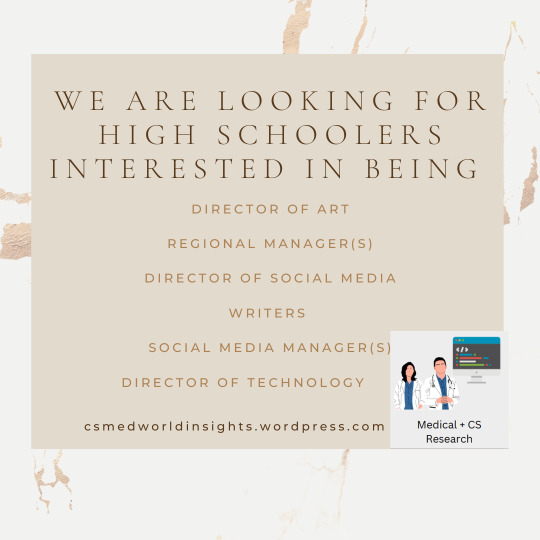
If you need a MEANINGFUL leadership role and you’re interested in pursuing a STEM major, please click this link to fill out the application.
#medical field#research#tech#health infomatics#software engineering#education#educational#high school#medicine#college#writing#leadership#ivy league#college applications#extracurricularactivities#social media#instagram#stemblr#stem#reddit#discord#tiktok#fun#biomedical engineering#jobs#flexible#interesting#computer science#teenagers#unpaid intern
1 note
·
View note
Text
Medical Grade Thermocouple Wire Market Overview and Regional Outlook Study 2017 – 2032
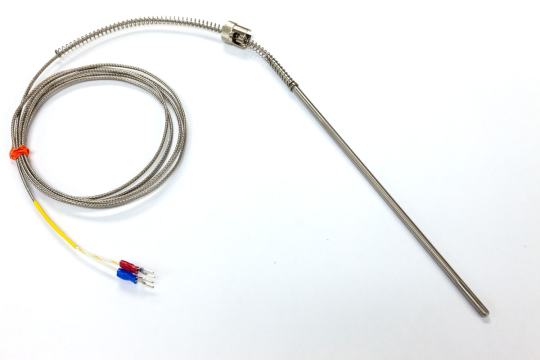
The market for medical grade thermocouple wire is witnessing steady growth due to the increasing demand for accurate and reliable temperature measurement in the medical industry. Thermocouples are widely used in various medical applications, including monitoring body temperature, laboratory testing, and medical equipment calibration.
Market Overview of Medical Grade Thermocouple Wire:
Technological Advancements: Advancements in thermocouple wire technology, such as the development of high-precision sensors and miniaturization, are driving the market growth. These advancements enable accurate temperature measurements in medical devices.
Healthcare Industry Expansion: The expanding healthcare industry, including hospitals, clinics, and research laboratories, is creating a substantial demand for medical grade thermocouple wire. These wires are widely used in medical devices, such as patient monitoring systems, incubators, and surgical equipment.
Stringent Regulations: The medical industry is subject to strict regulations regarding patient safety and product quality. Medical grade thermocouple wires comply with these regulations, ensuring reliability and accuracy in temperature measurement, which is a key factor driving their adoption.
Increasing Awareness: Growing awareness among healthcare professionals and researchers about the benefits of using thermocouple wires in medical applications is boosting the market. These wires offer advantages such as high accuracy, fast response time, and compatibility with various medical devices.
Key Factors Driving the Medical Grade Thermocouple Wire Market:
Rising Focus on Patient Safety: The healthcare industry's increasing emphasis on patient safety and comfort is driving the demand for medical grade thermocouple wires. These wires help in precise temperature monitoring, ensuring optimal patient care.
Growing Demand for Minimally Invasive Procedures: The rising preference for minimally invasive procedures requires accurate temperature sensing and monitoring during surgeries. Medical grade thermocouple wires enable real-time temperature measurements, enhancing the safety and success rates of such procedures.
Advancements in Medical Device Technologies: The continuous advancements in medical device technologies, such as wearable devices and remote patient monitoring systems, are fueling the demand for medical grade thermocouple wires. These wires play a crucial role in temperature sensing within these devices.
Increasing Research and Development Activities: The ongoing research and development activities in the medical field, including the development of new drugs, medical treatments, and diagnostic techniques, rely on accurate temperature measurements. Medical grade thermocouple wires are essential components in such research activities.
Growing Geriatric Population: The global increase in the geriatric population is driving the demand for medical devices and healthcare services. Medical grade thermocouple wires find extensive applications in temperature monitoring devices used for elderly care, such as patient monitors and wearable health trackers.
COVID-19 Impact: The COVID-19 pandemic has increased the demand for medical devices and equipment, including temperature monitoring systems. Thermocouple wires are used in various COVID-19-related applications, such as vaccine storage and transport, ICU patient monitoring, and fever detection systems.
Expansion of Home Healthcare: The rising trend of home healthcare services and the need for portable medical devices have led to an increased demand for medical grade thermocouple wires. These wires enable temperature monitoring in portable devices used for home healthcare purposes.
Increasing Adoption of Wireless Thermocouple Systems: The market is witnessing a shift towards wireless thermocouple systems, which offer convenience, ease of use, and reduced clutter. Medical grade thermocouple wires are an integral part of these wireless systems, driving their demand.
Collaborations and Partnerships: Key players in the medical device industry are entering into collaborations and partnerships to develop innovative solutions. Such collaborations involving medical grade thermocouple wire manufacturers contribute to market growth.
Growing Focus on Precision Medicine: The increasing focus on precision medicine, which involves personalized treatment based on individual characteristics, requires accurate temperature monitoring in various medical procedures. Medical grade thermocouple wires play a vital role in delivering precise temperature measurements for effective treatment outcomes.
We recommend referring our Stringent datalytics firm, industry publications, and websites that specialize in providing market reports. These sources often offer comprehensive analysis, market trends, growth forecasts, competitive landscape, and other valuable insights into this market.
By visiting our website or contacting us directly, you can explore the availability of specific reports related to this market. These reports often require a purchase or subscription, but we provide comprehensive and in-depth information that can be valuable for businesses, investors, and individuals interested in this market.
“Remember to look for recent reports to ensure you have the most current and relevant information.”
Click Here, To Get Free Sample Report: https://stringentdatalytics.com/sample-request/medical-grade-thermocouple-wire-market/3577/
Market Segmentations:
Global Medical Grade Thermocouple Wire Market: By Company
• TE Wire&Cable
• Johnson Matthey
• Heraeus
• Sandvik (Kanthal)
• BASF
• OMEGA Engineering
• Belden
• Pelican Wire
• National Instruments
• Indutrade (Pentronic)
• Pyromation
• Dwyer Instruments
• Tempco
• Durex Industries
• Marlin Manufacturing Corporation
• Multi/Cable Corporation
• Ellab
• Temprel
• Thermo-Electra
• Hayashidenko
Global Medical Grade Thermocouple Wire Market: By Type
• Type T
• Type K
• Other
Global Medical Grade Thermocouple Wire Market: By Application
• Pharmaceutical Enterprise
• Hospital
• Other
Global Medical Grade Thermocouple Wire Market: Regional Analysis
All the regional segmentation has been studied based on recent and future trends, and the market is forecasted throughout the prediction period. The countries covered in the regional analysis of the Global Medical Grade Thermocouple Wire market report are U.S., Canada, and Mexico in North America, Germany, France, U.K., Russia, Italy, Spain, Turkey, Netherlands, Switzerland, Belgium, and Rest of Europe in Europe, Singapore, Malaysia, Australia, Thailand, Indonesia, Philippines, China, Japan, India, South Korea, Rest of Asia-Pacific (APAC) in the Asia-Pacific (APAC), Saudi Arabia, U.A.E, South Africa, Egypt, Israel, Rest of Middle East and Africa (MEA) as a part of Middle East and Africa (MEA), and Argentina, Brazil, and Rest of South America as part of South America.
Visit Report Page for More Details: https://stringentdatalytics.com/reports/medical-grade-thermocouple-wire-market/3577/
Reasons to Purchase Medical Grade Thermocouple Wire Market Report:
• To obtain insights into industry trends and dynamics, including market size, growth rates, and important factors and difficulties. This study offers insightful information on these topics.
• To identify important participants and rivals: This research studies can assist companies in identifying key participants and rivals in their sector, along with their market share, business plans, and strengths and weaknesses.
• To comprehend consumer behaviour: these research studies can offer insightful information about customer behaviour, including preferences, spending patterns, and demographics.
• To assess market opportunities: These research studies can aid companies in assessing market chances, such as prospective new goods or services, fresh markets, and new trends.
• To make well-informed business decisions: These research reports give companies data-driven insights that they may use to plan their strategy, develop new products, and devise marketing and advertising plans.
In general, market research studies offer companies and organisations useful data that can aid in making decisions and maintaining competitiveness in their industry. They can offer a strong basis for decision-making, strategy formulation, and company planning.
Medical Grade Thermocouple Wire Market Research Report Contains Answers to your following Questions
Which Manufacturing Technology is Used for Medical Grade Thermocouple Wire? What Developments Are Going On in That Technology? Which Trends Are Causing These Developments?
Who Are the Global Key Players in This Medical Grade Thermocouple Wire Market? What's Their Company Profile, Their Product Information, and Contact Information?
What Was Global Market Status of Medical Grade Thermocouple Wire Market? What Was Capacity, Production Value, Cost and PROFIT of Medical Grade Thermocouple Wire Market?
What Is Current Market Status of Medical Grade Thermocouple Wire Industry? What's Market Competition in This Industry, Both Company, and Country Wise? What's Market Analysis of Medical Grade Thermocouple Wire Market by Taking Applications and Types in Consideration?
What Are Projections of Global Medical Grade Thermocouple Wire Industry Considering Capacity, Production and Production Value? What Will Be the Estimation of Cost and Profit? What Will Be Market Share, Supply and Consumption? What about Import and Export?
What Is Medical Grade Thermocouple Wire Market Chain Analysis by Upstream Raw Materials and Downstream Industry?
What Is Economic Impact On Medical Grade Thermocouple Wire Industry?
What are Global Macroeconomic Environment Analysis Results? What Are Global Macroeconomic Environment Development Trends?
What Are Market Dynamics of Medical Grade Thermocouple Wire Market? What Are Challenges and Opportunities?
What Should Be Entry Strategies, Countermeasures to Economic Impact, Marketing Channels for Medical Grade Thermocouple Wire Industry?
Click Here, To Buy Premium Report: https://stringentdatalytics.com/purchase/medical-grade-thermocouple-wire-market/3577/?license=single
About US:
Stringent Datalytics offers both custom and syndicated market research reports. Custom market research reports are tailored to a specific client's needs and requirements. These reports provide unique insights into a particular industry or market segment and can help businesses make informed decisions about their strategies and operations.
Syndicated market research reports, on the other hand, are pre-existing reports that are available for purchase by multiple clients. These reports are often produced on a regular basis, such as annually or quarterly, and cover a broad range of industries and market segments. Syndicated reports provide clients with insights into industry trends, market sizes, and competitive landscapes. By offering both custom and syndicated reports, Stringent Datalytics can provide clients with a range of market research solutions that can be customized to their specific needs
Contact US:
Stringent Datalytics
Contact No - +1 346 666 6655
Email Id - [email protected]
Web - https://stringentdatalytics.com/
#Medical Grade Thermocouple Wire#Thermocouple Technology#Temperature Measurement#Medical Devices#Healthcare Industry#Biomedical Applications#Thermocouple Sensors#Medical Equipment#Temperature Monitoring#Diagnostic Devices#Surgical Instruments#Patient Care#Clinical Research#Temperature Sensing#Biotechnology#Laboratory Instruments#Quality Control#Regulatory Compliance#Medical Instrumentation#Patient Monitoring#Invasive Procedures#Medical Testing#Precision Measurement#Life Sciences#Remote Monitoring#Sterilization Processes#Heat Management#Data Logging#Therapeutic Devices#Research and Development.
0 notes
Text
you know i was thinking about it and since both the force and the inner workings of the human mind are arguably non-observable phenomena i think force-based academia should look a lot like psychology. current arguments and achievements of note include:
are the living and universal force actually different???
are the living and universal force actually connected at all???
those two factions of academics who hate each other's guts and theories and methodology (feat. pragmatists who figured out that the theories work together really effectively when practiced??? just saying)
FIGURING OUT WHY IT WORKS IS SECONDARY TO THE FACT THAT IT DOES WORK, JOCASTA
YOU CANNOT JUST DO THINGS WITH THIS METHOD WHEN YOU CAN'T ESTABLISH ITS SCIENTIFIC VALIDITY, YODA
that one researcher who accidentally won the space nobel prize in physics while trying to figure out how it is Physically Possible for the Jedi to do That One Thing
we have no empirical evidence that "the force" exists and therefore we can ONLY make conclusions based on observable events--- (loud angry yelling)
incredible amounts of popular misinformation and pseudoscience being distributed to the public still somehow
psychometric abilities: discrete or dimensional?
look. this experiment was completely unethical and we would never do anything like it today BUT---
this used to be true but then we told people about it and it changed as a result of that awareness. no we're not lying to you----
everything can be 100% traced back to a biomedical source
nothing can be 100% traced back to a biomedical source
force abilities are actually linked to overarching social factors like socioeconomic status of parents and--- *yelling from the back* OKAY BUT WHAT DO WE DO WITH THAT
look. listen. 60% applicability is golden in this field. you're a hard science researcher you wouldn't understand how hard it is to study an invisible energy field with a mind of its own
and, of course, the interdisciplinary argument staple
that isn't actually a real science :/
649 notes
·
View notes
Text
Engineered protein filaments originally produced by bacteria have been modified by scientists to conduct electricity. In a study published recently in the journal Small, researchers revealed that protein nanowires—which were modified by adding a single compound—can conduct electricity over short distances and harness energy from moisture in the air.
"Our findings open up possibilities for developing sustainable and environmentally friendly electrical components and devices, based on proteins," says Dr. Lorenzo Travaglini, lead author on the paper. "These engineered nanowires could one day lead to innovations in energy harvesting, biomedical applications and environmental sensing."
Continue Reading.
66 notes
·
View notes
Text
An oil-free super-lubricant created from potato proteins could pave the way for sustainable engineering and biomedical applications, thanks to research led by the University of Leeds.
The team says the groundbreaking aqueous material can achieve super lubricity or near zero friction by mimicking actions found in biology, such as the synovial fluids which articulate cartilage in human joints.
Engineering an eco-friendly, efficient, and functional aqueous lubricant has eluded researchers until now. Many, if not most, aqueous lubricants use materials that are nearly exclusively derived from synthetic chemistry.
Read more.
#Materials Science#Science#Oils#Lubricants#Plants#Biomaterials#Proteins#University of Leeds#Self Assembly#Food
21 notes
·
View notes
Text
A system prioritising the overcoming of low levels of material wellbeing and productivity levels, and usually coming out of peasant patriarchal societies and often also colonial oppression (among other major disadvantages), all the while being militarily invaded and/or besieged, creates conditions not exactly conducive to the development of egalitarian social structures and environmentally constructive impacts. In these historical conditions it is a marvel that there were any successes in improving standards of living, raising environmental standards, engaging in reforestation, reducing or preventing waste, pre-empting consumerism, developing recycling programmes and attaining high volumes of recycling, improving access to education, providing free and universal health care, guaranteeing full employment and job security and even setting up lasting conservation areas, among other major feats. Add to this the development of cutting-edge social practices and policies like gender parity efforts in Burkina Faso, reconciliation and pacification methods (even if fraught with violence) in Mozambique, revolutionary applications of agronomy in Guinea Bissau and the Cabo Verde Islands and world-renowned successes in space, biomedical, health, conservation, engineering, ecology and biotechnology research and applications in the USSR, Cuba and the PRC, and the record is even more impressive.
Salvatore Engel-Di Mauro, Socialist States and the Environment: Lessons for Eco-Socialist Futures
40 notes
·
View notes
Text
The College of Iatrics
Previously located in the now destroyed city cube that had previously been above the Thaumanova Research Facility before it went critical, the College of Iatrics was an asuran college which focuses on medicinal knowledge and can best be compared to biomedical engineering.
Known primarily for their pioneering usage of magic and traditional medicine, it wasn't uncommon to see other races come by the college for first aid training, simply on account of the skill of the medics teaching at the facility.
Under the watchful eye of Dean Xell, a bit of a curmudgeonly old asura whose sternness was known throughout the city, students entering into the College of Iatrics would focus on a vast array of medical applications as they moved through college, focusing in on their final area of study as they got into their final years there.
The focuses for the students of Iatrics were as varied as the students there, including studies in genetics, biomedical devices, traditional medicine using natural methods, advanced applications in magical healing, and emergency response, to name a few.
The college has had a number of very notable graduates, though tragically, many of them were either killed or forced to be the ones to treat the injured and dying following the reactor meltdown.
The loss of the College of Iatrics has broadly been considered one of the worst losses since the exodus, along with its sister college Agronometrics, due to the scope of their research and the primary focuses they both covered.

#thaumanova reactor#thaumanova#college of iatrics#rata thauma#I specifically didn't use my name for the city cube in case others would like to use this school but don't call it rata thauma#still tagging it though for personal tracking on my blog fjkdlsjfkdls
19 notes
·
View notes
Text
Healing with Acoustic Resonance
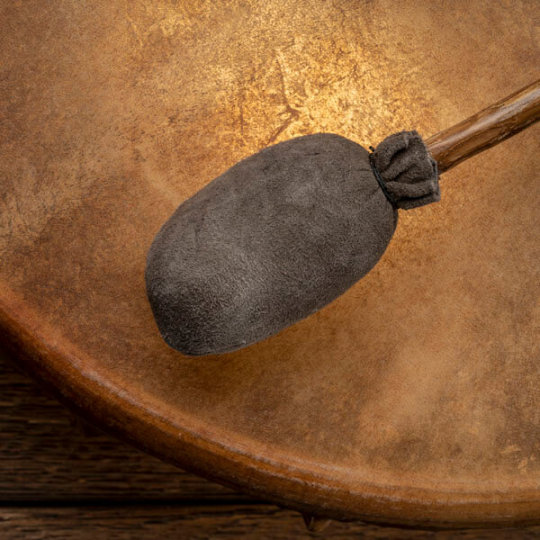
Drumming is a profound way to promote healing. Through acoustic resonance, drumming helps restore the vibrational integrity of body, mind, and spirit. Acoustic resonance is the ability of a sound wave to impart its energy to a substance such as air, wood, metal, or the human body, making it vibrate in sympathy. For example, when you tap a tuning fork in proximity to another one of the same tone, both will vibrate. Acoustic resonance is an important consideration for instrument builders, as most acoustic instruments use resonators, such as the strings and body of a violin, the length of tube in a flute, and the shape of a drum membrane. A single-headed frame or hoop drum works best for acoustic resonance healing--the larger the drum, the greater the resonance.
The drum is a powerful tool for healing. As we play the drum, the drum then plays our bodies. The various frequencies of the drum interact with our own resonant frequencies, forming new harmonic alignments. Through the natural law of resonance, the sound waves produced by the drum impart their energy to the resonating systems of the body, mind and spirit, making them vibrate in sympathy. When we drum, our living flesh, brainwaves and spiritual energy centers entrain or synchronize to the sound waves and rhythms. This sympathetic resonance has the following key effects:
It produces deeper self-awareness by inducing synchronous brain activity. Research has demonstrated that the physical transmission of rhythmic energy to the brain synchronizes the two cerebral hemispheres. When the logical left hemisphere and the intuitive right hemisphere begin to pulsate in harmony, the inner guidance of intuitive knowing can then flow unimpeded into conscious awareness. The ability to access unconscious information through symbols and imagery facilitates psychological integration and a reintegration of self. Drumming also synchronizes the frontal and lower areas of the brain, integrating nonverbal information from lower brain structures into the frontal cortex, producing feelings of insight, understanding, integration, certainty, conviction, and truth, which surpass ordinary understandings and tend to persist long after the experience, often providing foundational insights for religious and cultural traditions.
It releases negative feelings, blockages, and emotional trauma. Drumming can help people express and address emotional issues. Unexpressed feelings and emotions can form energy blockages. The physical stimulation of drumming removes blockages and produces emotional release. Sound vibrations resonate through every cell in the body, stimulating the release of negative cellular memories.
It accesses the entire brain. The reason rhythm is such a powerful tool is that it permeates the entire brain. Vision for example is in one part of the brain, speech another, but acoustic resonance penetrates the whole brain. The sound of drumming generates dynamic neuronal connections in all parts of the brain even where there is significant damage or impairment such as in Attention Deficit Disorder (ADD). According to Michael Thaut, director of Colorado State University's Center for Biomedical Research in Music, "Rhythmic cues can help retrain the brain after a stroke or other neurological impairment, as with Parkinson’s patients…." The more connections that can be made within the brain, the more integrated our experiences become.
It induces natural altered states of consciousness. Rhythmic drumming induces altered states, which have a wide range of therapeutic applications. A landmark study by Barry Quinn, Ph.D. demonstrates that even a brief drumming session can double alpha brain wave activity, dramatically reducing stress. The brain changes from Beta waves (focused concentration and activity) to Alpha waves (calm and relaxed), producing feelings of euphoria and well-being. Alpha activity is associated with meditation, shamanic trance, and integrative modes of consciousness.
It helps us to experience being in resonance with the natural rhythms of life. Rhythm and resonance order the natural world. Dissonance and disharmony arise only when we limit our capacity to resonate totally and completely with the rhythms of life. The origin of the word rhythm is Greek meaning "to flow." We can learn to flow with the rhythms of life by simply learning to feel the beat, pulse, or groove while drumming. When drummers feel this rhythmic flow, especially at a slower, steady beat, they can shift into a state of deep relaxation and expanded awareness. It is a way of bringing the essential self into accord with the flow of a dynamic, interrelated universe, helping us feel connected rather than isolated and estranged.
#shamanic drumming#drumming#shamanic practice#shamanism#consciousness#shamanic healing#altered states#resonance#sound healing
32 notes
·
View notes
Text
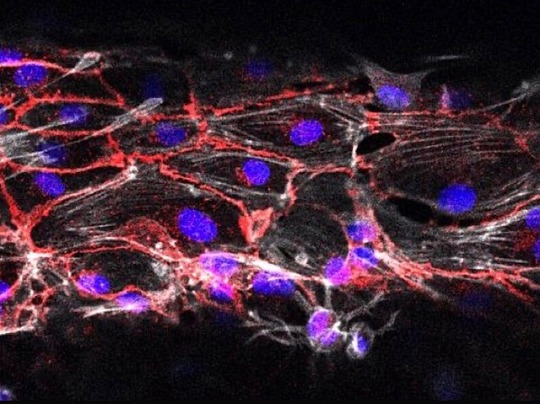
Magnetic Morphing
Using magnetic forces to remotely shape 3D printed hydrogel scaffolds with biomedical applications such as for growing endothelial cells in vessel networks (pictured)
Read the published research paper here
Image from work by Ruoxiao Xie and Yuanxiong Cao, and colleagues
Department of Materials, Department of Bioengineering and Institute of Biomedical Engineering, Imperial College London, London and Department of Physiology, Anatomy and Genetics, Kavli Institute for Nanoscience Discovery, University of Oxford, UK
Image originally published with a Creative Commons Attribution 4.0 International (CC BY 4.0)
Published in Science Advances, February 2024
You can also follow BPoD on Instagram, Twitter and Facebook
#science#biomedicine#immunofluorescence#biology#hydrogel#3d printing#endothelial cells#blood vessels#magnets#bioengineering
15 notes
·
View notes
Text
[CN] MLQC Lucien's Through Thousands of Mirrors event translation (Day 2 - Friday)
⚠️ SPOILER ALERT ⚠️
This post contains a HEAVY SPOILER for the event that has not been released in EN yet! Feel free to notify me if there are any mistakes in the translation~

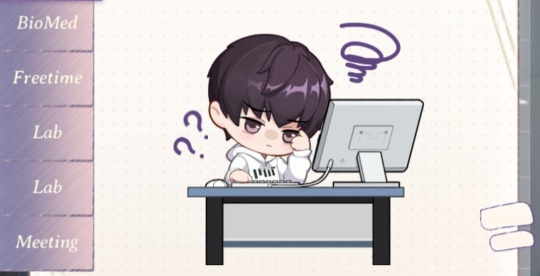
Through Thousands of Mirrors Event | Day 1 | Day 2 (You're here!) | Day 3 | Day 4 | Day 5 | Day 6 | Day 7 | HS/Uni SSR Story: Monochrome Scenery

-
[PREVIEW]
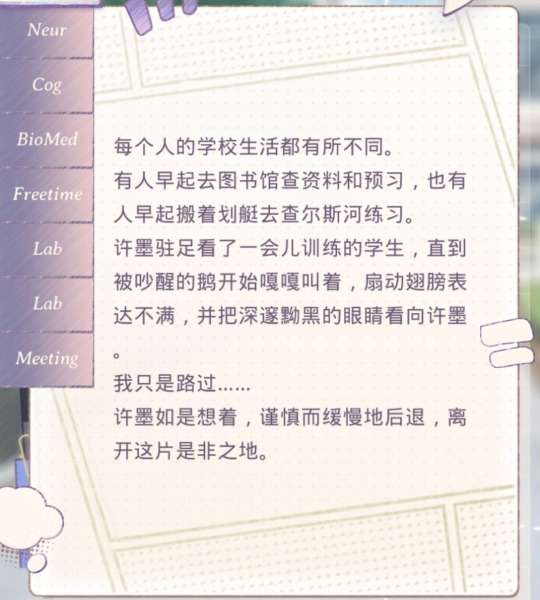
Everyone's school life is different. Some people wake up early to go to the library to research and study in advance, while others get up early to row on the Charles River for practice.
Lucien stops and watches the students training for a while until a woken goose begins to quack, flaps its wings in discontent, and fixes its deep, dark eyes on him.
I'm just passing by...
Lucien thought. He carefully and slowly backs away, leaving the dangerous place*.
-
[T/N: "是非之地" (shìfēi zhī dì) is a Chinese phrase that literally translated to "a place of right and wrong". it more or less mean a place where one is apt to get into trouble; in this case a place where there's a goose about to chase you at the slightest provocation😂. Funny how he now gets along well with another goose in current farming event LOL]
Also the fact that Lucien's campus is near Charles River basically confirms that his campus is definitely MIT; just get parodied to avoid copyright issues (in case if PG want to make merch of it).
-
[NEUROSCIENCE]
After class, Dr. Lawson stays for a while to chat with Lucien. It's unusual for Dr. Lawson to do so.
"Doctor, what's the matter?
"Did you already know the content we discussed today?"
"Yes, but I'm still very happy to hear it again."
-
[COGNITIVE NEUROSCIENCE]
When every piece of data is where it should be, within the expected range, and operates as it should, one should rightfully obtain the expected results, shouldn't they?
The irrefutable fact gives its answer with a smile: Nope!
-
[BIOMEDICAL SCIENCE]
Today, this class has a special guest lecturer. In order to help students gain a deeper understanding of the subject matter and the broader applications of biomedical science, the professor has invited his working forensic scientist friend.
Pretty cool.
Wait, isn't this professor's network a bit too extensive?
-
[FREE TIME]

No one dislikes Fridays.
Especially a Friday when everything at hand has been taken care of and you earned some free time.
In a few hours, there will be other things to do, and the weekend should also be used to prepare for the upcoming week.
But at least for now, Lucien feels he deserves to enjoy the warm afternoon sunlight and the comfortable hammock.
-
[LAB]
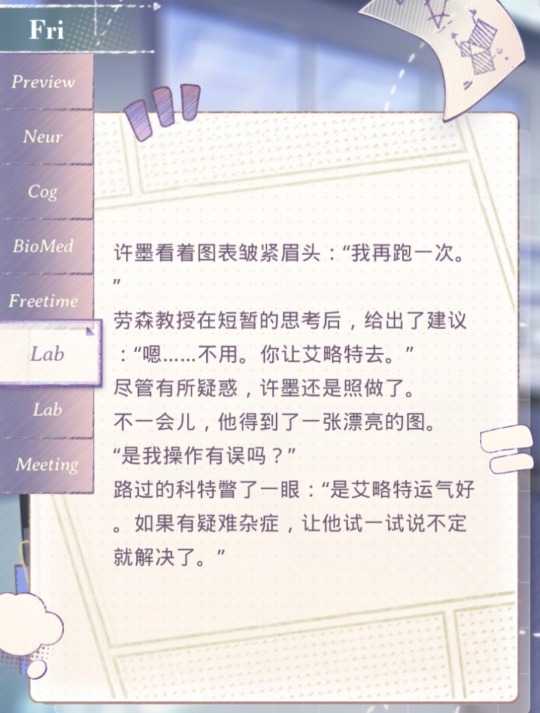
Lucien frowns as he looks at the chart, "Let me run it again."
After a brief moment of consideration, Professor Lawson gives a suggestion, saying, "Hmm... No need. Let Elliot run it instead."
Despite his doubts, Lucien still went ahead and followed the advice.
Not long after, he gets a beautiful chart.
"Did I make an error in my operation?"
Colt, who was passing by, glances and says, "Elliot is lucky. If there are any tricky problems, letting him give it a try might just solve them."
Lucien looks at the chart in his hand again and feels that, someday when recruiting people for his laboratory, he should perhaps consider luck as one of the factors.
-
[Tidbits: And he did 🥹 In the future, he will hire a scientist named Luo Ke, with one factor being the rumor that Luo Ke brings good luck to lab experiments [Lab Koi call] 🤣 It's cute that this not-so-scientific behavior can be traced back to this particular past event]
-
[LAB]
In the laboratory, many problems can be answered by Caroline.
"Caroline, did I use the reagents incorrectly?" Elliot asks in confusion.
"Caroline, do you have time to create a presentation poster for the project?" Dr. Lawson proudly asks, confident in Caroline's abilities.
"Caroline— the photocopier has stopped working," Colt wails in despair.
In the midst of the recurring "Caroline to the rescue"; only Lucien remains silent.
For the sake of easy record-keeping and review, he chooses to send an email.
-
[MEETING]
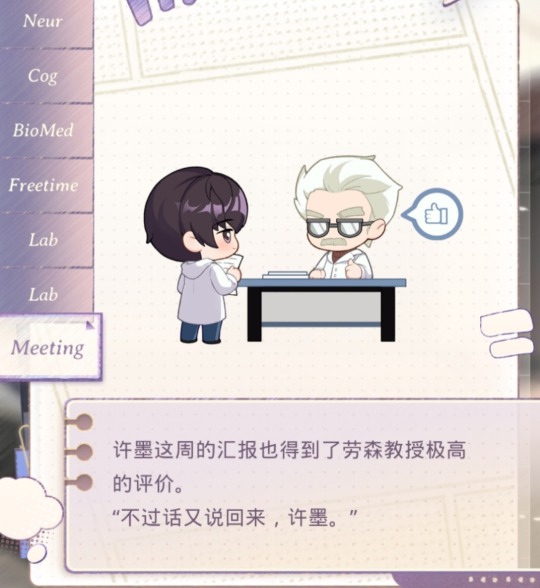
Lucien's report this week also receives extremely high praise from Professor Lawson.
"But then again, Lucien,"
"After you joined our laboratory, the electricity bill went up a bit, supposedly because of overnight power usage and keeping the lights on."
Lucien smiles quietly and then looks away.
#colt is fan zihang 2.0#and elliot was xm previous lab koi 🥹#mlqc lucien#mr love queen's choice#mlqc cn#mlqc spoiler#mlqc#mlqc translation#mr. love queen's choice#mr love lucien#mlqc xu mo#mlqc spoilers
31 notes
·
View notes
Text
Atlantis Expedition: Science Division Departments - Life Sciences Department
We're a bit further from the original post, having already done the medical department, so now it's time for the Life Sciences.
Much like the medical department, the notes for this underwent significant revision (nearly entirely re-done), to better granulate expectations for the department's duties and how they interact, primarily, with the medical department. Below is the original estimation, with struck text indicating revisions:
> Head: OC
> Contains: Earth biologists, bio- & biochemical engineers, astro/xeno-biologists, botany, environmental chemistry, zoology, microbiology
> Function: Auxiliary to Medical Department needs
> Examples of function: pharmaceutical synthesis, analysis of unknown species, biological database creation, gene therapies (pharmaceutical adjacent)
> Personnel quantity: 1 (Head) + 2 (Earth biologists) + 2 (bioE & biochemE) + 1 2 (astro/xenobio) + 1 (botany) + 1 (envchem) + 1 (zoo) + 2 1 (microbio) = 11
> Personnel quantity: 1 (Head) + 1 (physiologist) + 1 (geneticist) + 1 (astrobiologist) + 1 (xenobiologist) + 1 (microbiologist) + 1 (botanist) + 1 (zoologist) + 1 (biomedical engineer) + 1 (biochemical engineer) + 3 (medical laboratory scientists) = 13
> A/N: Both biologists also have training/specialization in genetics/gene mapping (assists both Carson and Katie), some input in requesting gate missions based on in-house needs
> A/N: Focus is on medical logistics and supporting Medical Department needs, research parameters fulfill SGC outlines of studying microevolutions and drug technology development.
Following on the parameters of 1) putting people through the inter-galactic theoretical shredder is expensive, and 2) said gate shredder will only be open for a certain amount of time, the vast majority of this department's work will be geared toward the analysis, creation, testing, and preparation of pharmaceutical drugs and other inventions of medical context.
Think compounding pharmacy but better equipped, and capable of researching new things - this department specializes in medical logistics. Wikipedia has a better description of this, so I'll pull a quote:
Medical logistics is the logistics of pharmaceuticals, medical and surgical supplies, medical devices and equipment, and other products needed to support doctors, nurses, and other health and dental care providers.[1] Because its final customers are responsible for the lives and health of their patients, medical logistics is unique in that it seeks to optimize effectiveness rather than efficiency.
As with most things contrived by the SGC, there's going to be a lot of blended specialties and overlap, heavily bolstered by technological innovation. These are people Carson Beckett likely hired, or at least had a heavily-weighted opinion when Rodney was going through the application packets, because the Life Sciences is at a one-step remove from actually handling patients, and handles a significant amount of labwork and research.
The revised numbers weigh heavily in favour of biologists, due to the sheer breadth and depth of the subject, and the fact that most of these are likely to have some sort of SGC training that would make them well-versed on what to expect on the expedition in terms of disease research and thus treatment solutions.
Unlike the medical department, which handles patients directly in different aspects, this is all one "team". If you're looking for a group of scientists that can technically have the same generic appellation that would make one of them go, "Well, actually-", this is the place to look.
On to the breakdown, notes included:
> Earth biologists
» 2x of these
» Specialties?
⇛ Human physiology (academic rather than medical context)
⇛ May function as a knowledge base to study how the physiology of the expedition changes by long-term habitation in Atlantis, assists in studying long-term effects of the ATA gene therapy, development of knowledge base as Earth-based physiology changes in reaction to Pegasus galaxy habituation (exposure to local diseases, eating of local foods, etc)
⇛ Geneticist
⇛ Same as the human physiologist, but in a genetic context
⇛ Studies genetic drift of the expedition and builds knowledge base for comparisons of baseline to genetic mutations that build up over time
> Astro/xenobiology
» 2x of these
⇛ 1 of each
» SGC special
» Studies the species and speciation of non-human humanoid species
⇛ Imports from studying the Jaffa, Goa'uld, and Replicators (xenobiologist in particular)
⇛ Overlap with parasitology and immunology/histocompatibility (Goa'uld and Jaffa, respectively)
> Microbiology
» "Most microbiologists specialize in a given topic within microbiology such as bacteriology, parasitology, virology, or immunology."
» Studies the species and speciation of bacteria, algae, fungi, and some types of parasites and their vectors
> Botany
» Study of species and speciation of plant species
» Outline of botany
> Zoology
» Study of species and speciation of non-human animal species
» Outline of zoology
> Biomedical engineer
» REVAMP from bio-engineering
» Actually makes the pharmaceuticals based on the feedstocks and processes biochem engineers designed for them
⇛ Works with biochem engineers to feedback on the design process of drug manufacturing
⇛ Biologics as well as inert (in comparison) materials for drug development
⇛ Pharmacology
⟹ Most likely all drugs are powdered for shelf-stability and ease of transportation
⭆ So their responsibility in this would be referencing the SGC formulary (how many books to a Frasier) on reconstituting these drugs
➾ Compounding
⭆ What about topical prescriptions? Gel-based? Powder for gels, as well
➾ More complex formulation
⭆ What about gases, for sedation?
➾ Probably compressed canisters?
> Biochemical engineer
» Would not have existed in the early 2000s as a field related to process engineering, so an SGC special
» Also useful for researching food preservation methods
» Synthesizes information from peers in this department to create pharmaceutical drugs and their manufacturing process
> Medical Laboratory scientist
» Does the legwork of processing samples for everyone, so needs a wide range of skills
⇛ 3x of these
⇛ Specialties
⟹ Immunology/histopathology/hematology
⭆ Human tissues
⟹ Microbiology/bacteriology
⭆ Bacterial forms of infection
⟹ Virology/mycology/parasitology
⭆ Non-bacterial forms of infection
➾ Routes of non-bacterial infection
> Environmental chemistry
» Role covered under biochem engineering
» Biochem engineers can cover the study of pollution that envirochems specialize in
Environmental chemistry section preserved to properly annotate the revisions, and what their original role was supposed to be (i.e. study pollution to solve Earth's pollution issues).
It occurred to me, while revising personnel lists, that the biologists in particular will need to divide their research into some broad categories, if they want to properly develop their research topics and what category of formulations they would require from the non-biologists in the department.
We have human species, yes, but that can be parsed from Milky Way to Pegasus galaxies, and from there Earth-based humans vs Jaffa (vs Goa'uld), and Pegasus-based humans (presumably humans, as they probably wouldn't know for sure that the Ancients were the default sentient or even default humanoid species in the Pegasus galaxy).
The human microbiome is incredibly important to understanding homeostasis, disease pathology, and various other interconnected factors. Because of this, the medical laboratory scientists will be heavily relied upon to develop cultures for study. I'm willing to believe that they have some nifty adapted technology to help them study all of these subjects I've shoved under multiple umbrellas, in the form of culturing processes, reagents, microscopes, analyzing software, preserving agents/methods, and the like.
After that, testing to see how these diseases - or potential diseases, if someone in the Pegasus galaxy hosts a bacteria, virus, fungus, or parasite that their immune system is natively robust to - might infect a member of the expedition. This is where a lot of back-and-forth would be done between the Life Sciences and Medical departments, so it wouldn't be uncommon to see people like, say, Biro (pathology) and Katie Brown (botany) jointly doing research on a pathogen.
There's already a lot of canonical evidence to support this specialist overlap being a necessary concern, from the the Hoffan drug (and the subsequent Michael arc), John Sheppard's infection from an Iratus bug bite in Conversion, Asurans, Lucius' drug, the crystals of M3X-387, Kirsan fever, Jennifer Keller's infection from something that was turning her into a Wraith hiveship in The Seed, and the Second Childhood parasite.
Depending on the type of infection, a lot of the personnel in this department will coordinate with each other to develop a knowledge base, including potential therapeutic remedies. If something already in stock cannot be used (see: a potential cross-applicability of penicillin), then they might make a request to the head of the expedition for a gate team to travel based upon any information they might have (ex: Teyla and Ronon going out for samples of the Enchuri plant for treating Kirsan fever).
Because of their support role as a department, the fact that all the scientists here can be used as in-house reference for the medical department, and their unique position to recommend gate missions for consideration on the roster, this department functions well as a bridging gap for the various demands the expedition has placed on them by the IOA and the SGC.
Total Life Sciences Department Personnel
Head of Department: 1
Biologists: 5
Engineers: 2
Laboratory Scientists: 3
Botany: 1
Zoology: 1
Total total: 13
I'll be going over canonical personnel such as Katie Brown in their own posts, but for now this is a general accounting of the expedition’s life sciences department.
7 notes
·
View notes
Text
New method enables fast, accurate estimates of cardiovascular state to inform blood pressure management
New Post has been published on https://thedigitalinsider.com/new-method-enables-fast-accurate-estimates-of-cardiovascular-state-to-inform-blood-pressure-management/
New method enables fast, accurate estimates of cardiovascular state to inform blood pressure management


If patients receiving intensive care or undergoing major surgery develop excessively high or low blood pressures, they could suffer severe organ dysfunction. It’s not enough for their care team to know that pressure is abnormal. To choose the correct drug to treat the problem, doctors must know why blood pressure has changed. A new MIT study presents the mathematical framework needed to derive that crucial information accurately and in real time.
The mathematical approach, described in a recent open-access study in IEEE Transactions on Biomedical Engineering, produces proportional estimates of the two critical factors underlying blood pressure changes: the heart’s rate of blood output (cardiac output) and the arterial system’s resistance to that blood flow (systemic vascular resistance). By applying the new method to previously collected data from animal models, the researchers show that their estimates, derived from minimally invasive measures of peripheral arterial blood pressure, accurately matched estimates using additional information from an invasive flow probe placed on the aorta. Moreover, the estimates accurately tracked the changes induced in the animals by the various drugs physicians use to correct aberrant blood pressure.
“Estimates of resistance and cardiac output from our approach provide information that can readily be used to guide hemodynamic management decisions in real time,” the study authors wrote.
With further testing leading to regulatory approval, the authors say, the method would be applicable during heart surgeries, liver transplants, intensive care unit treatment, and many other procedures affecting cardiovascular function or blood volume.
“Any patient who is having cardiac surgery could need this,” says study senior author Emery N. Brown, the Edward Hood Taplin Professor of Medical Engineering and Computational Neuroscience in The Picower Institute for Learning and Memory, the Institute for Medical Engineering and Science, and the Department of Brain and Cognitive Sciences at MIT. Brown is also an anesthesiologist at Massachusetts General Hospital and a professor of anesthesiology at Harvard Medical School. “So might any patient undergoing a more normal surgery but who might have a compromised cardiovascular system, such as ischemic heart disease. You can’t have the blood pressure being all over the place.”
The study’s lead author is electrical engineering and computer science (EECS) graduate student Taylor Baum, who is co-supervised by Brown and Munther Dahleh, the William A. Coolidge Professor in EECS.
Algorithmic advance
The idea that cardiac output and systemic resistance are the two key components of blood pressure comes from the two-element Windkessel model. The new study is not the first to use the model to estimate these components from blood pressure measurements, but previous attempts ran into a trade-off between quick estimate updates and the accuracy of estimates; methods would either provide more erroneous estimates at every beat or more reliable estimates that are updated at minute time scales. Led by Baum, the MIT team overcame the trade-off with a new approach of applying statistical and signal processing techniques such as “state-space” modeling.
“Our estimates, updated at every beat, are not just informed by the current beat; but they incorporate where things were in previous beats as well,” Baum says. “It’s that combination of past history and current observations that produces a more reliable estimate while still at a beat-by-beat time scale.”
Notably, the resulting estimates of cardiac output and systemic resistance are “proportional,” meaning that they are each inextricably linked in the math with another co-factor, rather than estimated on their own. But application of the new method to data collected in an older study from six animals showed that the proportional estimates from recordings using minimally invasive catheters provide comparable information for cardiovascular system management.
One key finding was that the proportional estimates made based on arterial blood pressure readings from catheters inserted in various locations away from the heart (e.g., the leg or the arm) mirrored estimates derived from more invasive catheters placed within the aorta. The significance of the finding is that a system using the new estimation method could in some cases rely on a minimally invasive catheter in various peripheral arteries, thereby avoiding the need for a riskier placement of a central artery catheter or a pulmonary artery catheter directly in the heart, the clinical gold standard for cardiovascular state estimation.
Another key finding was that when the animals received each of five drugs that doctors use to regulate either systemic vascular resistance or cardiac output, the proportional estimates tracked the resulting changes properly. The finding therefore suggests that the proportional estimates of each factor are accurately reflecting their physiological changes.
Toward the clinic
With these encouraging results, Baum and Brown say, the current method can be readily implemented in clinical settings to inform perioperative care teams about underlying causes of critical blood pressure changes. They are actively pursuing regulatory approval of use of this method in a clinical device.
Additionally, the researchers are pursuing more animal studies to validate an advanced blood pressure management approach that uses this method. They have developed a closed-loop system, informed by this estimation framework, to precisely regulate blood pressure in an animal model. Upon completion of the animal studies, they will apply for regulatory clearance to test the system in humans.
In addition to Baum, Dahleh and Brown, the paper’s other authors are Elie Adam, Christian Guay, Gabriel Schamberg, Mohammadreza Kazemi, and Thomas Heldt.
The National Science Foundation, the National Institutes of Health, a Mathworks Fellowship, The Picower Institute for Learning and Memory, and The JPB Foundation supported the study.
#Anesthesia#Animals#approach#arm#arteries#author#beats#Biomedical engineering#blood#blood pressure#Brain#Brain and cognitive sciences#computer#Computer Science#data#Disease#drug#drugs#Electrical Engineering&Computer Science (eecs)#engineering#experimental#factor#Foundation#framework#gold#harvard#Health#Health care#Health sciences and technology#heart
4 notes
·
View notes
Note
Dudeeee you work in a cancer cell research lab?? That's insanely cool and I'm really really curious how you got into this field and what you do for your job because I'm also interested in pursuing a career that involves working The Cool Lab but I'm so. Lost???
Yes I do and I'm so glad you asked! Getting into scientific research can be kind of confusing for someone without a background in it so I'm totally willing to help out!
Fair warning before we start, all of the info I'll be giving you pertains to pursuing a career in biological/biomedical research. I can't speak for how to get into other fields like chemical or engineering research because I don't work in them.
First and foremost, what exactly you wanna do is tied to your level of education. I have a bachelors of science degree in biology, and if all you wanna do is work as a lab technician, that's all you need. Lab technicians do the day-to-day lab work like keeping the machines up and running, performing simple experiments, ensuring everything is in stock, assisting in data collection, and keeping the place from burning down. I got this job 3 months after graduating college and the reasons I got this job are because 1) my degree is biology meant I already knew the basics about cancer cells and all the other biological factors that impact them and 2) I had a ton of hands on lab experience when I was an undergrad. I volunteered in a lab during my undergraduate and got a ton of hands on experience with basic lab skills like gel electrophoresis, PCR, and biosafety skills.
All that being said, only a bachelors does mean you'll hit a wall eventually and not be able to do more without another higher degree. For example, while I do run a bunch of fancy cytometers and nanoparticle analyzers and aid in data collection for research projects, I do not create any of my own research projects nor do I publish anything. If you're interested in heading research projects, you will need to pursue a higher degree like a masters or PhD in biology or biomedical research or another field that interests you.
The nice thing about being a lab technician though is you're not stuck. If you get a bachelors, find a position as a lab technician, and find you want to pursue that higher degree, your lab job makes your application for these programs look amazing since you already have a ton of hands on experience. I could quit my job and get into a masters or PhD program within the next application cycle because of all the experience I've gotten.
Now, as for how to find these jobs, I recommend checking universities, which is where I'm currently employed. Individual research labs headed by a principal investigator (or PI for short, which is some who holds a PhD and is in charge of the lab and all of its research projects) always need lab technicians or lab assistants. The only issue is that most of these places are grant funded meaning the money could run out and you'd be out of a job. Of course you'll get plenty of heads up and usually when this happens another lab in the same department can hire you, but I know some people don't like the instability.
If you're looking for something more stable as a lab technician, I recommend finding what is called a core facility to work at. A core facility is a facility that houses and contains a bunch of super expensive lab equipment that is shared among researchers because it's too expensive for individual researchers to purchase. For example, a microscope core facility would have electron microscope that various researchers could use as those are often far too expensive for one lab to purchase and use on their own.
I work as a lab technician in a core facility and I'm not gonna say the specialty because it's pretty niche and I don't want to accidentally doxx myself. My main job is to keep those shared machines (most of which cost $300k or more a piece) up and running and able to consistently produce quality data for various researchers in the department, which is a cancer cell biology department. Additionally, my job is technically a university job and therefore I don't have to worry about a grant running out of money. I really like my job because it is stable and consistent but there's enough variation between all the researchers I help to keep it interesting.
Sorry for how long this post is! I know I rambled a lot but I also know that getting into and navigating this field can be kind of confusing for people who don't know someone in it. I hope this helps clarify a few things!
#thanks for the ask!#also and this is just opinion#but i think everyone interested in a phd should work as a lab tech for a hot minute before grad school#because the number of phd students i know who regret locking themselves into a phd program#rather than just getting into the industry is a lot of people#a master program whatever#if you wanna rush into that after undergrad go for it#simply because its less commitment compared to a phd#my ramblings
5 notes
·
View notes
Text
The science of a Bidirectional Brain Computer Interface with a function to work from a distance is mistakenly reinvented by laymen as the folklore of Remote Neural Monitoring and Controlling
Critical thinking
How good is your information when you call it RNM? It’s very bad. Is your information empirically validated when you call it RNM? No, it’s not empirically validated.
History of the RNM folklore
In 1992, a layman Mr. John St. Clair Akwei tried to explain a Bidirectional Brain Computer Interface (BCI) technology, which he didn't really understand. He called his theory Remote Neural Monitoring. Instead of using the scientific method, Akwei came up with his idea based on water. Lacking solid evidence, he presented his theory as if it were fact. Without any real studies to back him up, Akwei twisted facts, projected his views, and blamed the NSA. He lost his court case and was sadistically disabled by medical practitioners using disabling pills. They only call him something he is not. Since then, his theory has gained many followers. Akwei's explanation is incorrect and shallow, preventing proper problem-solving. As a result, people waste life-time searching for a true scientific explanation that can help solve this issue. When you call it RNM, the same will be done to you as to Mr. Akwei (calling you something you are not and sadistically disabling you with pills).
Critical thinking
Where does good research-based information come from? It comes from a university or from an R&D lab.
State of the art in Bidirectional BCI
Science-based explanation using Carnegie Mellon University
Based on the definition of BCI (link to a scientific paper included), it’s a Bidirectional Brain Computer Interface for having a computer interact with the brain, and it’s extended only with 1 new function to work from a distance.
It’s the non-invasive BCI type, not an implanted BCI. The software running on the computer is a sense and respond system. It has a command/function that weaponizes the device for a clandestine sabotage against any person. It’s not from Tesla, it’s from an R&D lab of some secret service that needs it to do surveillance, sabotages and assassinations with a plausible deniability.
You need good quality information that is empirically validated, and such information comes from a university or from an R&D lab of some large organization. It won’t come from your own explanations because you are not empirically validating them which means you aren’t using the scientific method to discover new knowledge (it’s called basic research).
Goal: Detect a Bidirectional BCI extended to work from a distance (it’s called applied research, solving a problem using existing good quality information that is empirically validated)
Strategy: Continuous improvement of Knowledge Management (knowledge transfer/sharing/utilization from university courses to the community) to come up with hypotheses + experimentation with Muse2 to test your hypotheses and share when they are proved).
This strategy can use existing options as hypotheses which is then an applied research. Or, it can come up with new, original hypotheses and discover new knowledge by testing them (which is basic research). It can combine both as needed.
Carnegie Mellon University courses from Biomedical Engineering (BME)
Basics (recommended - make sure you read):
42665 | Brain-Computer Interface: Principles and Applications:
Intermediate stuff (optional - some labs to practice):
2. 42783 | Neural Engineering laboratory - Neural engineering involves the practice of using tools we use to measure and manipulate neural activity:
https://www.coursicle.com/cmu/courses/BMD/42783/
Expert stuff (only if you want to know the underlying physics behind BCI):
3. 18612 | Neural Technology: Sensing and Stimulation (this is the physics of brain cells, explaining how they can be read from and written into)
https://www.andrew.cmu.edu/user/skkelly/18819e/18819E_Syllabus_F12.pdf
You have to read those books to facilitate knowledge transfer from the university to you.
With the above good quality knowledge that is empirically validated, the Bidirectional BCI can be likely detected (meaning proved) and in the process, new knowledge about it can be discovered.
Purchase a cheap unidirectional BCI device for experiments at home
Utilize all newly gained knowledge from the above books in practice to make educated guesses based on the books and then empirically validate them with Muse2. After it is validated, share your good quality, empirically validated information about the undisclosed Bidirectional BCI with the community (incl. the steps to validate it).
Python Project
Someone who knows Python should try to train an AI model to detect when what you hear is not from your ear drums. Here is my initial code: https://github.com/michaloblastni/insultdetector You can try this and send me your findings and improvements.
How to do research
Basic research makes progress by doing a literature review regarding a phenomenon, then identifying main explanatory theories, making new hypotheses and conducting experiments to find what happens. When new hypotheses are proved the existing knowledge is extended. New findings can be contributed back to extend existing theories.
In practice, you will review existing scientific theories that explain i.e. the biophysics behind sensing and stimulating brain activity, and you will try to extend those theories by coming up with new hypotheses and experimentally validating them. And then, you will repeat the cycle to discover more new knowledge. When it's a lot of iterations, you need a team.
In applied research, you start with a problem that needs solving. You do a literature review and study previous solutions to the problem. Then, you should synthesize a new solution from the existing ones, and it should involve extending them in a meaningful way. Your new solution should solve the problem in some measurably better way. You have to demonstrate what your novel solution does better i.e. by measuring it, or by proving it with some other way.
In practice, you will do a literature review of past designs of Bidirectional BCI and make them your design options. Then, you will synthesize a new design option from all the design options you reviewed. The new design will get you closer toward making a Bidirectional BCI work from a distance. Then, you will repeat the cycle to improve upon your design further until you eventually reach the goal. When it's a lot of iterations, you need a team.
Using a Bidirectional BCI device to achieve synthetic telepathy
How to approach learning, researching and life
At the core, the brain is a biological neural network. You make your own connections in it stronger when you repeatedly think of something (i.e. while watching an expert researcher on youtube). And your connections weaken and disconnect/reconnect/etc. when you stop thinking of something (i.e. you stop watching an expert on how to research and you start watching negative news instead).
You train yourself by watching/listening/hanging out with people, and by reading about/writing about/listening about/doing certain tasks, and also by other means.
The brain has a very limited way of functioning because when you stop repeatedly thinking of something it soon starts disappearing. Some people call it knowledge evaporation. It’s the disconnecting and reconnecting of neurons in your biological neural network. Old knowledge is gone and new knowledge is formed. It’s called neuroplasticity. It’s the ability of neurons to disconnect, connect elsewhere, etc. based on what you are thinking/reading/writing/listening/doing.
Minimize complexity by starting from the big picture (i.e. a theory that explains a phenomenon). Then, proceed and do problem solving with a top-down decomposition into subproblems. Focus only on key information for the purpose of each subproblem and skip other details. Solve separate subproblems separately.
2 notes
·
View notes